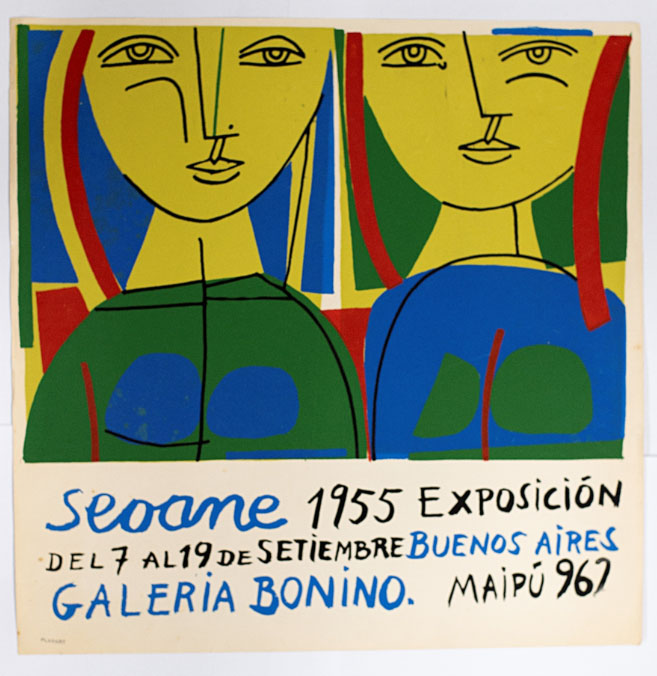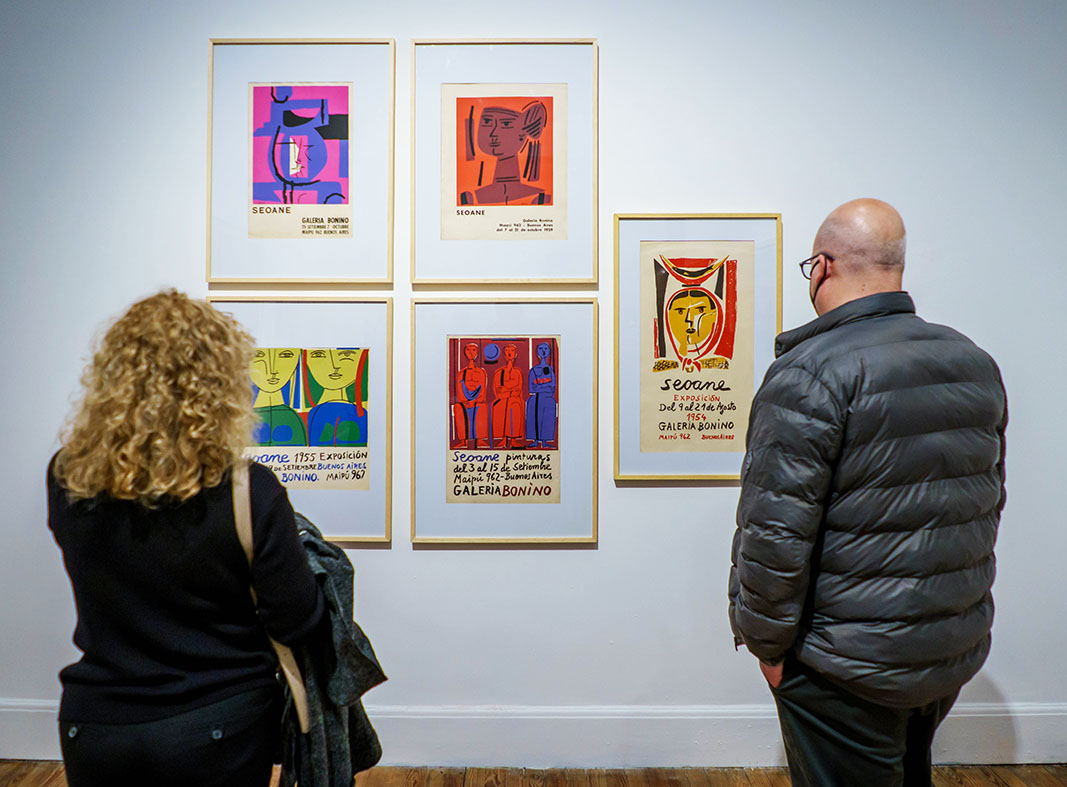Until November 27, 2022, the exhibition Materials Seoane. Between Galicia and Argentina is exhibited at the Enrique Larreta Spanish Art Museum in the city of Buenos Aires. In tune with the transatlantic condition of the double cultural anchorage of Luis Seoane (Buenos Aires, 1910 – A Coruña, 1979), this exhibition has been conceived and developed in dialogue between Argentina and Galicia, in a pooling of pieces from collections of the two stages in which the artist performed. As the curatorial proposal, by Pablo García Martínez and the author of these lines, maintains, in this journey that combines material searches, iconographies and devices developed from its two geographies, it aims to enable the review of stories and plots of the artistic modernity in which Seoane was a leading actor.
Between the beginning of the 1930s and the end of the 1970s, Seoane developed a vast multidisciplinary, multifaceted body of work. He produced paintings, murals, prints; he edited books and magazines and illustrated record covers; he made tapestries, ceramics and multiples; wrote poetry, prose and plays, managed or participated in cultural projects and artistic dissemination. His work is inscribed within the broad modernism of the 20th century, dynamic and cosmopolitan; the development of his visual work from the synthetic resolution of the images and his material and disciplinary experimentation link him to that current that dominated the artistic production of his time. Seoane managed -in his work and in his exchanges- a high level of cultural updating. In this direction, he maintained constant dialogues with key actors of the national and international cultural scene, and at the same time spread speeches and images of fundamental modern artists: prominent figures such as Lucio Fontana, Raquel Forner, appear in the publications he edited or in which he participated. Piet Mondrian or Lasar Segall. Along with this modern line, his questioning of certain aspects of cultural tradition was constant: his choice of stencils, mosaics, textiles, ceramics and, above all, woodcut, are exemplary in this regard.
Although his paintings of popular themes and his still lifes, with planes of saturated colors and clear graphic lines, are his most recognized images, there are also other less well-known facets of his production, such as his creation in tapestry, a technique with which he participated in the cultural environment in Buenos Aires since the 1960s, beginning with the invitation by Gracia Cutuli to participate with her work in the El Sol Gallery experience. [1] Like the prints, the tapestries are multiple works located halfway between seriality and craftsmanship, which at that time gained greater recognition in the artistic field and affirmed its insertion in the sphere of a "high culture" that broadened its circulation channels and its consuming public.
His position of critical questioning, sustained throughout his career, already appeared in his graphic interventions in public space when he was a law student in Santiago de Compostela and continued in the anti-Franco drawings of the Thirteen prints of treason (1937), the caricatures for the “Market for Arts and Letters” section (1940-1942), the woodcuts on Fallen, the military Face of the beast of command and Repression, all works from the sixties or Trying to hit ideas (1972), until his last work published during his lifetime, where he evoked the Falangist repression in the closing of Images of Galicia (1978). [2]
Louis Seoane. Serigraph from the Peasants album. 1954. Bonino Gallery Editions. National Engraving Museum Collection. Buenos Aires.
In a broad sense, the various works in which he addressed aspects of Galician and Argentine life as a cultural and historical affirmation can also be considered part of this thematic and ideological line, with the invocation of the struggles of the people and their heroic figures, their representation of popular types -such as fishermen, gauchos, horsemen, peasants and shellfish, the figures of medieval Galicia or the actors of the 19th-century Argentine circus- or of characters associated with historical deeds, such as his graphic conception of María Pita or Martina Céspedes. Within modern art, his work maintained virtual dialogues, in aesthetic or ideological terms, with various referents: just as Pablo Picasso was a fundamental presence for Seoane, Fernand Léger or Diego Rivera were key to his interests in regard to contemporary murals ; Joaquín Torres-García or José Guadalupe Posada were important Latin American figures, while Tomás Maldonado, Ernesto Deira or León Ferrari became some of his Argentine interlocutors. For many of the porteño and Galician artists of his generation, or of younger generations, Seoane himself was a benchmark, both in aesthetic and ethical terms: valued for his production, recognized for his generosity and openness, he maintained links with creators from different artistic directions.
His visual production received early recognition in the cultural milieu of Buenos Aires when the publication of his book of forty-nine drawings Homenaje a la Torre de Hércules (Nova, 1944) was celebrated with an agasajo, or «banquet to Luis Seoane», in which numerous renowned intellectuals and artists who were active in the city at the time participated. Jorge Romero Brest already pointed out at that time Seoane's modernist anchorage by highlighting the dualities that tense and enrich his work. [3]
To this early symbolic endorsement, some outstanding recognitions from the Argentine cultural field were added: his works were included in important national shipments to international events, such as the 1956 Venice Biennale or the 1958 Brussels International Exhibition; In 1962 he obtained the Palanza Prize from the National Academy of Fine Arts, which he joined as a full academician in 1967.
Seoane cultivated his intellectual project from an aesthetic and ethical position, in which the relationship between art and life was addressed from a universal humanist imprint. In this project, the experimental will -in formal, material, technical terms- was combined with a vocation for cultural democratization. Through a set of woodcuts, oil paintings, ceramics, serigraphs, stencils, textile work, multiple objects, magazines, books, posters and record covers, this exhibition proposes to account for the paths and experimental diversity of Seoane's production .
Notes:
1. El Sol was a gallery and workshop in Buenos Aires, run by Gracia Cutuli and Jack Mergherian, who commissioned cartoon designs from artists that were later made into tapestry; In addition to Seoane, other prominent names in Argentine art participated in this activity, such as Carlos Alonso, Héctor Basaldúa, Edgardo Giménez, Pérez Celis, Rogelio Polesello and Clorindo Testa.
2. Cf. Silvia Dolinko, “Images of Galicia: Engravings by Luis Seoane in Buenos Aires”, Madrygal. Magazine of Galician Studies, no. 20, Complutense University of Madrid, 2017, p. 73-86.
3. Jorge Romero Brest, “A cartoonist and an engraver”, Correo Literario, a. 2, no. 16, July 1, 1944, p. 1.
* Special for Hilario. Arts Letters Crafts.


